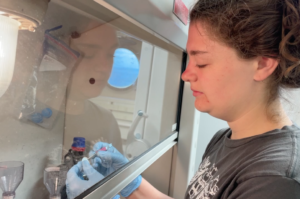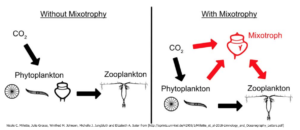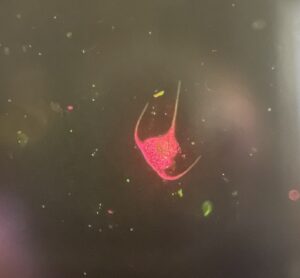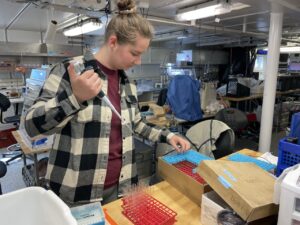Tuesday, June 06, 2023 – North Pacific Ocean (Latitude: 37.46.225 N, Longitude: 123.59.703 W)
Mixed Up Microbes
Food webs are characterized by a structure that includes producers and consumers. Producers use photosynthesis to convert energy from the Sun into food for the consumers. In the ocean, phytoplankton are the producers and considered to be autotrophs. Zooplankton are the consumers and are referred to as heterotrophs.

Heterotrophs do not have the ability to convert light energy into food and must rely on phytoplankton (producers) for survival. There is another group of organisms that have the ability to be producers and consumers. This unique group of microbes is called Mixotrophs and they can photosynthesize like autotrophs when light energy and nutrients are available or switch to heterotrophic consumer behaviors and start grazing on other forms of phytoplankton for nourishment as the nutrients from an upwelling cycle start to diminish.

Claire Cook (Skidaway Institute of Oceanography at the University of Georgia) and Rickie Ewton (University of Rhode Island) are investigating the responses of mixotrophs throughout the upwelling event. Claire is hoping to determine the tipping point that pushes mixotrophs away from producing and toward consuming and Rickie is investigating the growth and grazing rates of the mixotrophs. Both scientists are collecting seawater samples throughout the duration of the upwelling cycle. They filter their samples to remove all the plankton that is larger than the mixotrophs they are investigating.


Rickie is investigating various types of plankton, including phytoplankton, zooplankton and mixotrophic plankton. She expects to see smaller populations at the start of the upwelling event, “because the phytoplankton are just reaching the surface and haven’t had time replicate much.” As the plume continues, more phytoplankton will start to replicate, thereby increasing the population until the nutrients run out. She expects grazer populations, like mixotrophs and zooplankton, “to increase a few days after the phytoplankton accumulate [near the surface] because grazers take longer to respond” to an upwelling event.
